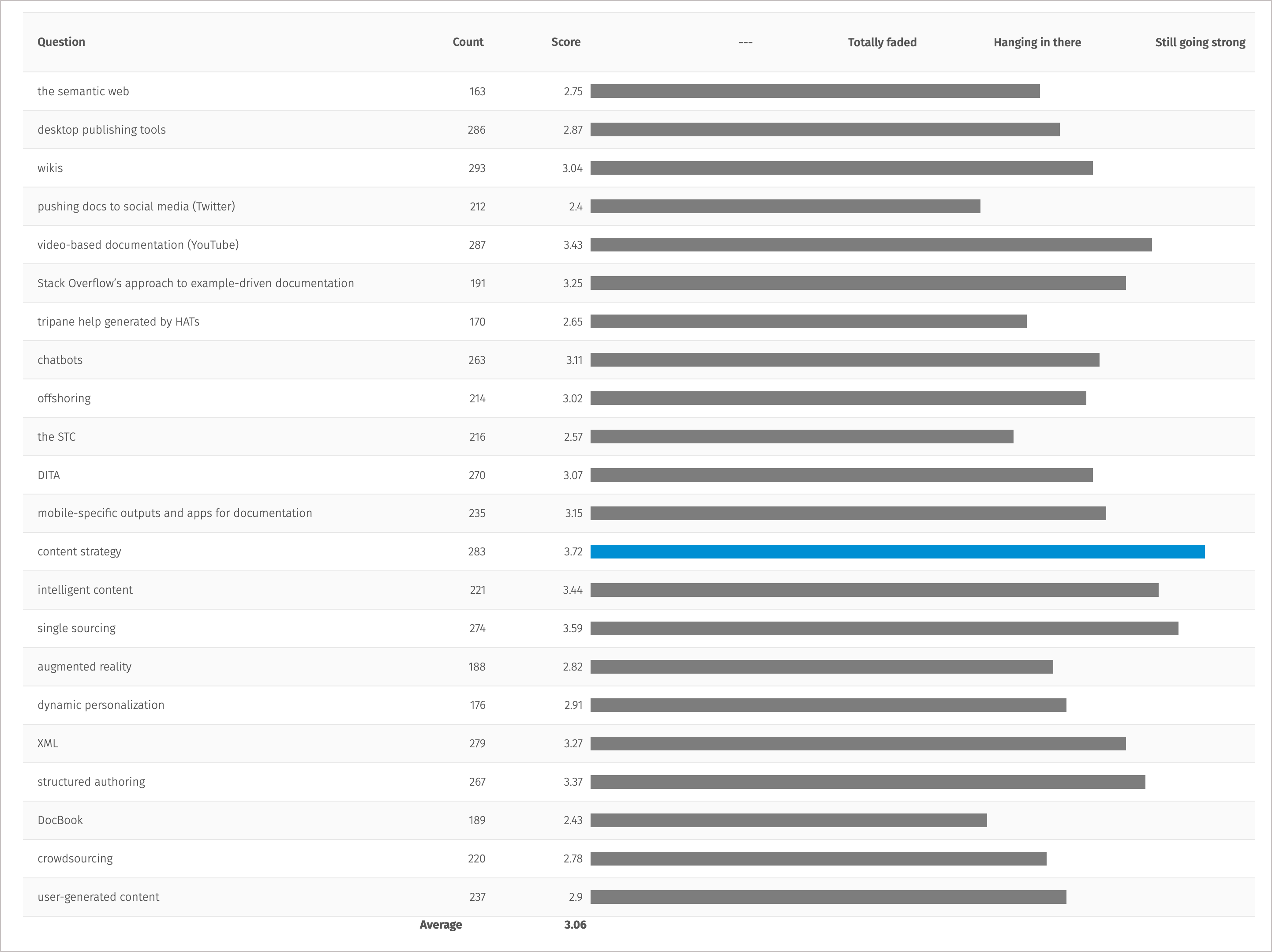Trends to
follow or forget
Analyzing reasons for embracing and/or abandoning 15 tech comm trends, and then applying the reasoning to assess the viability of present trends
By Tom Johnson / @tomjohnson
idratherbewriting.com
Slides: fizzled_trends
Survey about fizzled trends

Making sense of the responses
- Poor wording or lack of definitions?
- People's perceptions skewed?
- Natural resistance to being outdated?
- Anything that was ever a trend is here to stay. The trend makes sense in some context.
- A plurality of trends, more diverse/fragmented field practices?
My approach to trends
- Abandon effort to make industry generalizations. Focus instead on my own experiences.
- Look at 15 major trends I participated in during past two decades. With each, answer 4 questions:
| What is it? | |
| Why I adopted it | |
| Why I abandoned it | |
| Current status |
Overview of 15 trends
Larger goal
Use inductive reasoning to discover principles related to trends that will allow us to assess the viability of current trends
1. HATs and single-sourcing
| What is it? | Single-source content, generate complete web output |
| Why I adopted it | Produce both print and web content from the same source |
| Why I abandoned it | Needed collaborative platform for community contributions |
| Current status | Important because both PDF and web output still needed |
2. Wikis and crowdsourcing
| What is it? | Allow anyone to edit and contribute. Distributes work to the crowd |
| Why I adopted it | Worked at a company with lots of willing volunteers |
| Why I abandoned it | Crowdsourcing doesn't work for docs |
| Current status | Wikis popular internally. Externally, evolved into GitHub pull requests |
3. Faceted filtering
| What is it? | Dynamically narrow down content based on filters |
| Why I adopted it | Abundance of content online made findability critical |
| Why I abandoned it | Facets not a clear fit for information products. Weak tool support |
| Current status | Not common in docs. XML and web drifted apart |
4. Screencasting
| What is it? | Short videos that show how to do a specific task |
| Why I adopted it | Popularity of YouTube showed multimedia as a learning preference |
| Why I abandoned it | Videos not well suited for developer docs, code how-to |
| Current status | Still popular but not common TW output due to high production costs |
5. Quick reference guides
| What is it? | Short 1-2 page guides that get users going on key tasks |
| Why I adopted it | Easy way to make text-based information appealing |
| Why I abandoned it | Getting started tutorials more common in dev docs |
| Current status | Common for hardware products. Often the only thing users read |
6. WordPress and web CMS's
| What is it? | Started out with blogging but evolved into a multipurpose platform |
| Why I adopted it | Easy way to create & manage websites. Lots of plugins & themes |
| Why I abandoned it | LAMP stack not supported in the enterprise. Cumbersome to update |
| Current status | Still popular for websites, but not for docs |
7. DITA
| What is it? | XML schema designed for documentation. Elements with rules |
| Why I adopted it | Grew tired of using tools not designed for TWs |
| Why I abandoned it | Markdown more common for developer tooling and workflows |
| Current status | Used in large enterprises because most CCMS's require XML structure |
8. Content strategy
| What is it? | Strategic analysis and planning about content. All the meta work around writing |
| Why I adopted it | Recognized the strategy work behind writing docs. Writing is commodity |
| Why I abandoned it | Strategy not as important as tactics. Success formula not a huge mystery |
| Current status | Still popular. Lots of variation in what content strategists actually do |
9. Scrum
| What is it? | Project methodology for agile. Short iterations, continuous integration |
| Why I adopted it | Made it easier to work with Scrum-based engineering teams |
| Why I abandoned it | Not a good fit for partially allocated resources |
| Current status | Common project methodology but has many variants and adaptations |
10. Tech comm and marcom
| What is it? | Documentation can be leveraged as a full-fledged marketing asset |
| Why I adopted it | Thought it would be good fit for tech writer who also blogs |
| Why I abandoned it | No openness about issues. Just release notes and tech tips |
| Current status | Intersection between domains should focus on content re-use |
11. Every page is page one
| What is it? | A style of writing that encourages standalone, modular articles |
| Why I adopted it | Obvious that web landscape would be dominant space for information |
| Why I didn't abandon it | Developers prefer lengthy pages -- they preserve context, allow Ctrl+F |
| Current status | Web patterns becoming second nature, including doc styles |
12. API documentation
| What is it? | Documentation proliferates with rise of web APIs |
| Why I adopted it | Higher demand in job market, and REST APIs more accessible |
| Why I didn't abandon it | Working on a code level is interesting and challenging |
| Current status | Will continue to be popular because APIs dominate the web |
13. Git and GitHub
| What is it? | Way to manage text files, allow distributed teams to collaborate. |
| Why I adopted it | Follow same workflows as software dev because docs also live in code |
| Why I abandoned it | Lack of community contributions. Complicated pre-release workflows |
| Current status | Used mostly with docs-as-code tools and dev docs |
14. Docs as code
| What is it? | Using more developer-centric tools and workflows for creating docs |
| Why I adopted it | Allow developer SMEs to collaborate and participate in docs |
| Why I didn't abandon it | Flexible and customizable, more enjoyable working in raw text |
| Current status | Common in dev docs, though more robust tooling requires tools teams |
15. Remote work
| What is it? | Discarding the workplace in favor of working remotely using virtual tools |
| Why I adopted it | Mandated with pandemic, suits work of tech comm well |
| Why I abandoned it | Hybrid model replaces WFH, social isolation lowers morale, community loss |
| Current status | World events could propel us into virtual, metaverse-like model |
Conclusions to draw?
1. What makes sense in one context might not make sense in another
2. Easier tools won't make non-writers willingly start writing docs
3. You're less likely to outgrow tools that are flexible, customizable, and hackable
4. To assess trends related to titles and roles, look at job postings for a reality check.
5. Trends start on the web before they make their way into tech comm
6. If you're working with developers, following their workflows, tools, and processes helps you connect with their world
Can these conclusions be used assess future trends?
Experiment: Assess whether fully remote work is here to stay or whether it's a temporary reconfiguration due to a time-bound event.
Extreme outcomes of 100% remote work?
- Talent sourced from all over the globe
- Workers who were once local now compete with workers living in cheaper areas. Pool of available writers grows.
- Tech writers hired in plug-and-play model on a per project basis, like a service
- Cost of labor comes down. Hourly rate changes from $60/hour to $20/hour
- Tech writers move to less expensive areas to live off the lower wages. Urban hubs decay, rural areas come to life
- Complete loss of company culture, team, morale
Can we assess this trend?
1. What makes sense in one context might not make sense in another.
Application: The post-pandemic world is a new context where previous models might no longer apply. Previously, fully remote workers were often contractors hired through outsourcing, and outsourcing didn't make local tech writers extinct. But in the context of a post-pandemic world, outsourcing might be more common because everyone would already be remote.
2. Easier tools won't make non-writers willingly start writing docs.
Application: Tech writing professions are here to stay because no matter the tooling, writing is a lot of work that non-writers just won't naturally start doing on their own. But the connection to remote work here isn't clear.
3. You're less likely to outgrow tools that are flexible, customizable, and hackable.
Application: Though not a tool, remote work offers much more flexibility and customization of schedules, location, family arrangements, and more. You can adapt your schedule to almost anything, attend virtual meetings, video conference from anywhere, interact with tools asynchronously, etc. The flexibility of the fully remote model suggests that it will win over models with more constraints.
4. To assess trends related to titles and roles, look at job postings for a reality check.
Application: Although many tech companies now offer permanent remote, it seems that most companies are offering hybrid models. Hybrid models would reduce the chances of a disruptive, globally distributed workforce and would keep things relatively the same. However, if permanent remote companies prove more competitive, they could accelerate the shift to remote work.
5. Trends start on the web before they make their way into tech comm.
Application: Look to engineers and web-centric tech companies as trendsetters. Many engineers seem suited to remote work because coding is a task requiring a lot of deep concentration and uninterrupted flow. Extended concentration is even more challenging to achieve given how social media has reduced our attention span dramatically. Most devs dislike meetings for the disruption and context switching. Remote work amplifies the isolation and might be a way engineers cling to possibilities for creative flow.
6. If you're working with developers, following their workflows, tools, and processes helps you connect with their world.
Application: If engineers prefer permanent remote, then tech writers (who interact mainly with engineers) should likely follow suit to match similar rhythms, workflows, tools, and preferences as engineers (at least in dev docs). Where engineers go, tech writers will follow.
Overall conclusion
It seems more likely than not that fully-remote work becomes the norm for tech companies in the future, but for the time being, most are adopting hybrid models.
Takeaway
Figure out how to excel in the remote work model now so that you can avoid burnout, zoom fatigue, social isolation, mental anxiety, lack of productivity, etc, in the future. Even if remote work doesn't stick, the techniques will make you more productive in the workplace anyway.Questions?

The end

Tom Johnson
— idratherbewriting.com
— @tomjohnson
— [email protected]